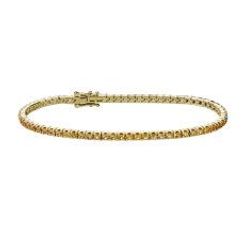
What is a sapphire?
Sapphires are derived from the mineral corundum. Commonly associated with a regal shade of blue, sapphires inspired the term “royal blue.” But sapphires range in color from green and yellow to orange and even violet.

Rob Lavinsky, iRocks.com – CC-BY-SA-3.0, CC BY-SA 3.0,
via Wikimedia Commons / Cropped from original
Mineral: Corundum
Origins: Kasmir, Myanmar, Sri Lanka,
Australia, Thailand, Cambodia,
Madagascar, United States (Montana)
Symbols: Good Fortune, Romance
Properties: Wisdom, Wealth
Durability: 9
ENHANCEMENTS
Heated and/or infused to improve color and clarity
CARE
Basic Gemstone Care
SIMILAR GEMSTONES
Pink Sapphire

What to Look for in Sapphires
When we think of sapphires we often think "blue", but sapphire refers to any colored corundum other than red, which qualifies as a ruby. Sapphires can be white, yellow, pink, green or purple.They also come “parti-colored,” which means they shift colors in different lighting. The most common parti-colored sapphires seemingly change from blue in daylight to purple in incandescent light. Sapphires are the traditional September birthstone. Sapphires look gorgeous in any jewelry setting, whether silver, gold or platinum. When choosing a sapphire, keep these characteristics in mind:
COLOR
Gemstone Color is often the most important aspect of a gemstone. Sapphires with a true, deep blue color are often the most desirable of these gemstones — and they’re more rare than other sapphire colors. Rubies are also the same mineral, corundum, as Saphpire in a red hue. Sapphires in other hues are known as fancy sapphires. Colorless sapphires offer the look of a diamond at a more budget-friendly price point, but without skimping on beauty and brilliance.

CUT
A gemstone cut should highlight its best aspects. Our sapphires are cut to showcase their distinctive combination of color, clarity and brilliance. To maximize reflection, sapphires may have a more shallow cut to allow in more light and sparkle, or they may be cut more deeply to showcase a dark saturation.

CLARITY
When speaking of gemstone clarity, natural gemstones contain inclusions, which are materials like gas bubbles, minerals or liquid that are trapped within the stone while it forms. The fewer visible inclusions in a sapphire, the more desirable it is. However, sapphires occasionally feature an inclusion known as an asterism, or the star effect, in which a dazzling six-ray star pattern appears on its surface.

SIZE (CARAT)
Sapphires are denser than diamonds, so what we consider a carat weight for a sapphire differs from that of a diamond. That’s why the size of gemstones, including sapphires, is measured by their diameter in millimeters. A sapphire measuring six millimeters in diameter is roughly equivalent to one carat.

ENHANCEMENT
Most gemstones on the market today are enhanced with heat treatments or infusions to help improve the color and clarity. Our sapphires undergo rigorous internal inspections and are of the highest quality.

HARDNESS & WEARABILITY
Sapphires are very durable, earning a 9 out of 10 on the Mohs scale of hardness. A diamond, the hardest of all gemstones at a rating of 10, is the only natural thing that can scratch a sapphire. This makes sapphire jewelry suitable for everyday wear, whether in a beautiful ring setting, a bold pendant necklace or sparkling earrings.

Choosing the Right Sapphire Jewelry
Ultimately, selecting a piece of sapphire jewelry should come down to what you love. A sapphire that makes you think of the sky, or the ocean, or your favorite person’s eyes brings good feelings and terrific sparkle to your look. Sometimes called the “wisdom stone,” sapphire jewelry makes a meaningful gift for graduates. Green sapphires, known as the “stone of fidelity,” makes them a wonderful choice for a sapphire engagement ring or anniversary gift. Sapphires are associated with spiritual truths and positive thinking.
Shop Popular Sapphire Jewelry
Famous Sapphire Gemstones
Royalty has an enduring love affair with this gemstone, which adorns the Imperial State crown and the engagement rings of Josephine Bonaparte and Lady Diana Spencer—who chose her stunning 12-carat, oval sapphire ring to match her baby blue eyes. That famous ring was recently passed down to Kate Middleton by Diana’s son, Prince William.
LEARN MORE ABOUT GEMSTONES
Sapphires are just one of many gemstones you’ll find at Blue Nile. Learn about other gemstones, and fall in love with all of them.


















